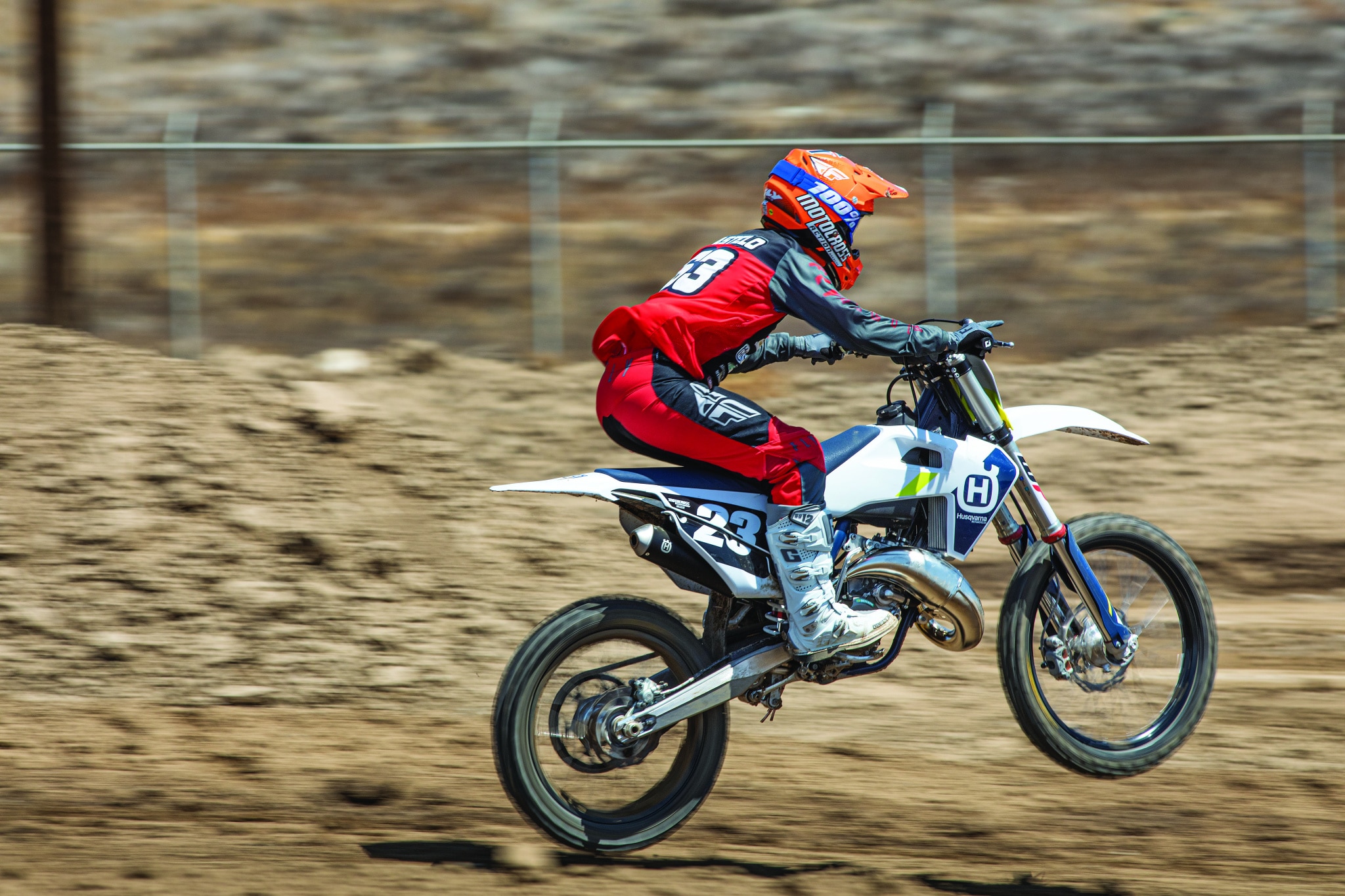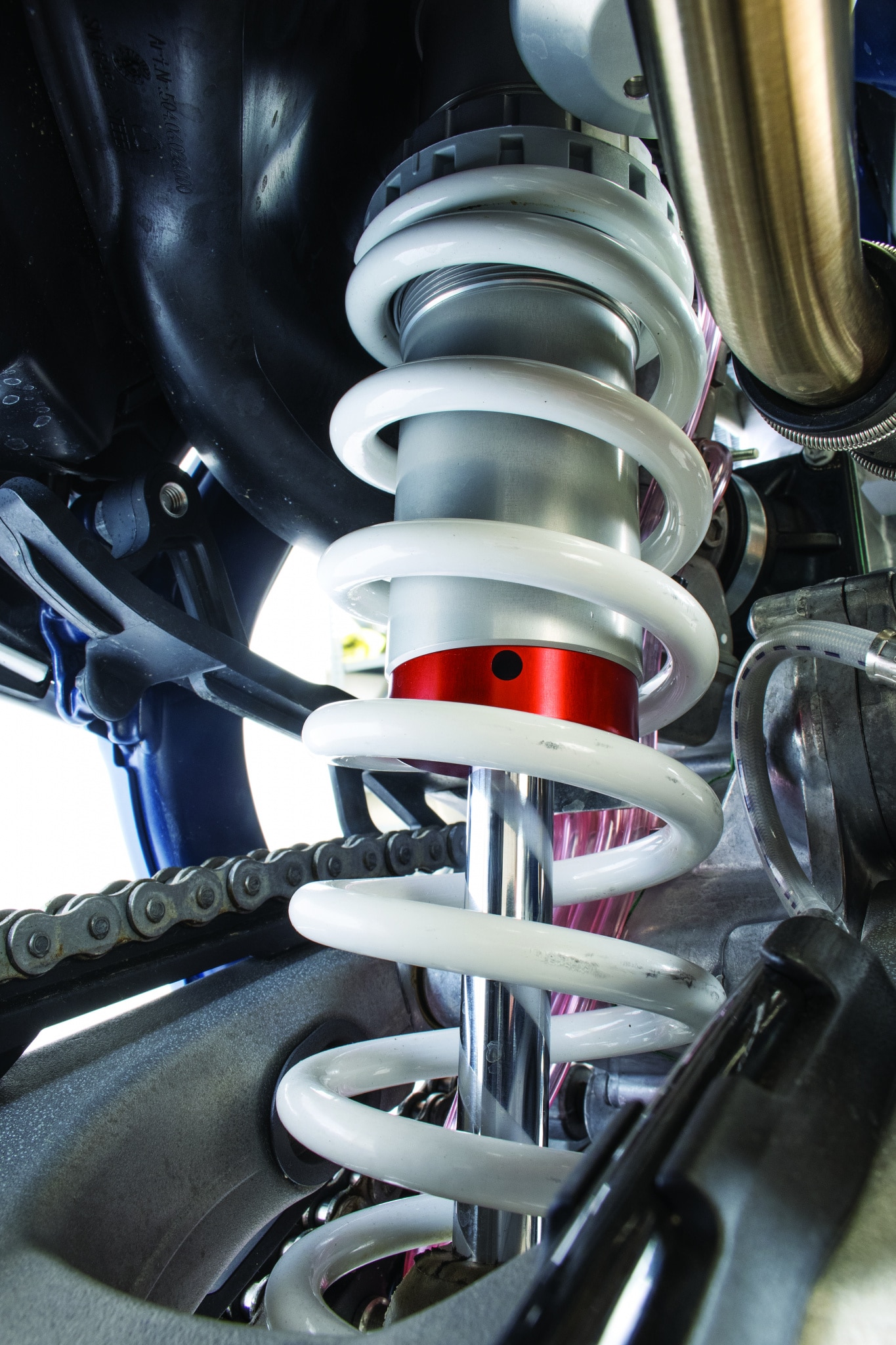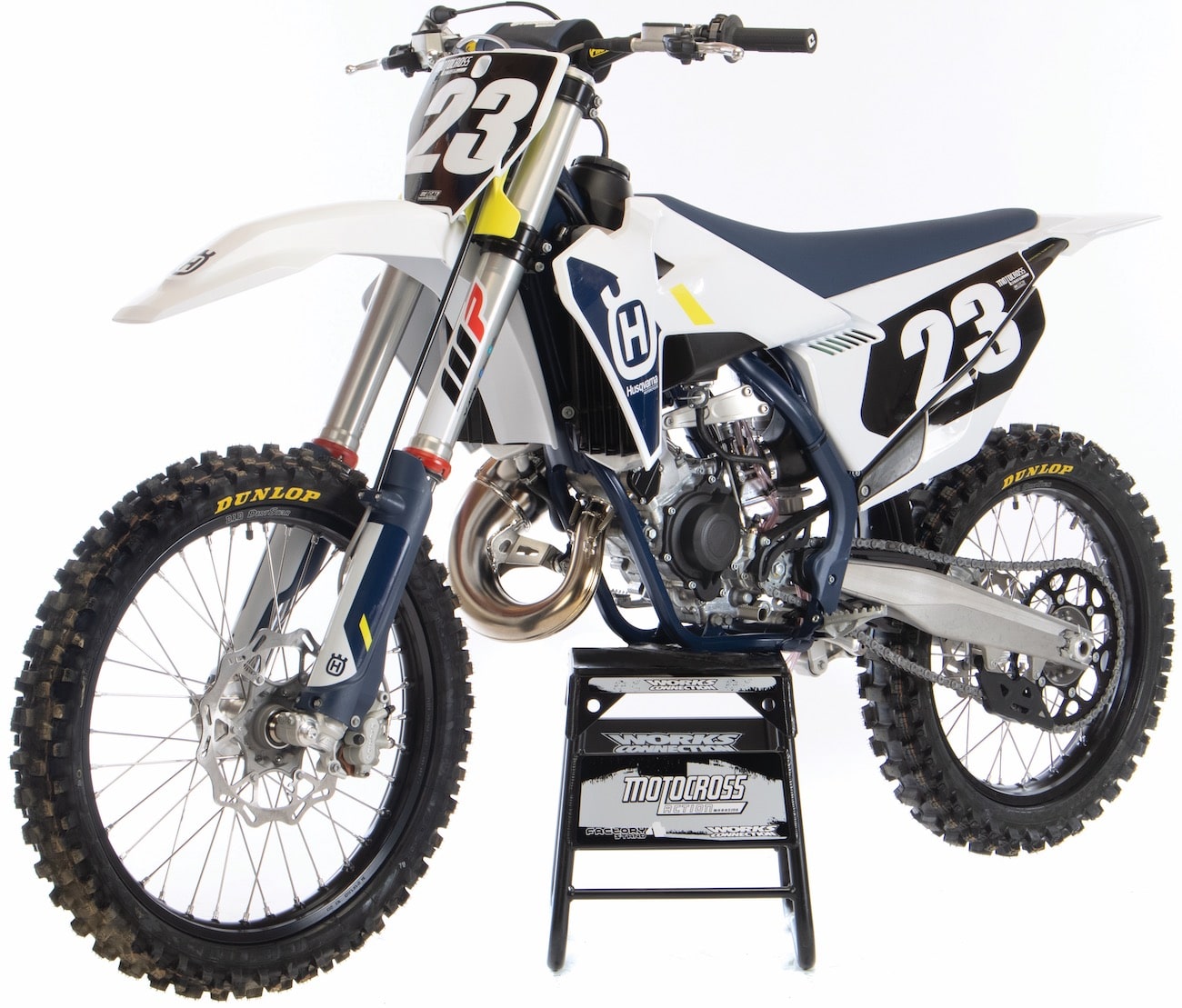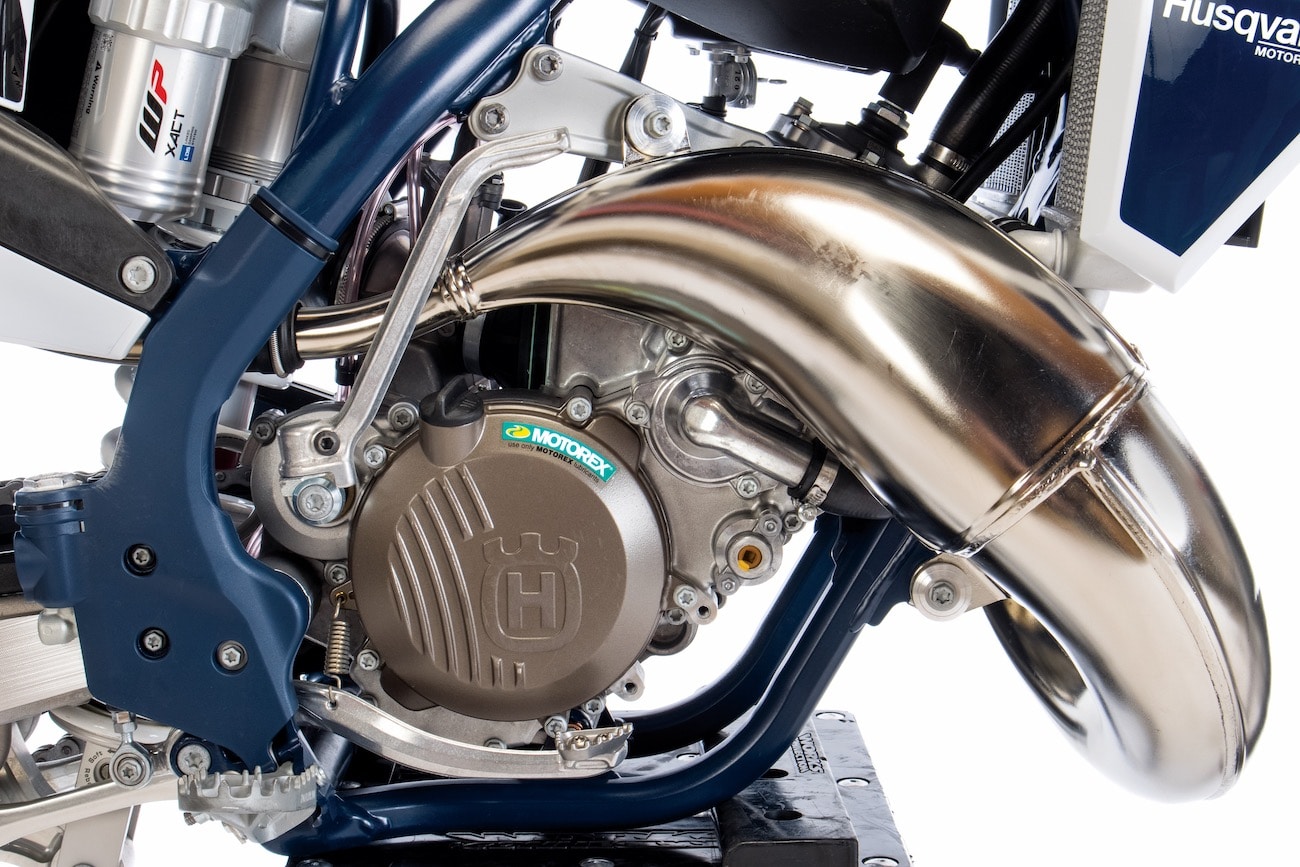MXA RACE TEST: THE REAL TEST OF THE 2022 HUSQVARNA TC125
 THE GEAR: Jersey: Fly Racing Kinetic, Pants: Fly Racing Kinetic, Helmet: Fly Racing F2, Goggles: 100% Accuri 2, Boots: Gaerne SG12.
THE GEAR: Jersey: Fly Racing Kinetic, Pants: Fly Racing Kinetic, Helmet: Fly Racing F2, Goggles: 100% Accuri 2, Boots: Gaerne SG12.
Q: FIRST AND FOREMOST, IS THE 2022 HUSQVARNA TC125 BETTER THAN THE 2021 MODEL?
A: Yes, but only the 2022 clutch update could be considered a performance booster.
It should be obvious to everyone who waited for 2022 bikes to show up in the showroom this year that the production of motorcycles during the age of COVID was a difficult task. Making all-new 2022 motorcycles with upgraded frames, engines, electronics and accoutrements was out of the question—not because it couldn’t be done, but because it would delay every step of the production process even further. With dealer’s floors bare, the manufacturers worried that they would lose a large portion of their dealer network to bankruptcy if they didn’t find a solution that would put bikes in consumers hands sooner rather than later.
What was that solution? Release the 2021 models as 2022 models with nary an update. That would speed production, lessen supply delays and fill the pipeline. Don’t believe this theory? Think about the 2022 new bike offerings. (1) Kawasaki made no changes to the KX250 and KX450, save for graphics. (2) Yamaha made no changes to its YZ250F and YZ450F, save for a new rear-wheel assembly. Yamaha did update the YZ125 and YZ250 two-strokes, but it was obvious that those updates were long overdue and most likely in the works way before the pandemic hit. (3) Suzuki made zero changes to the 2022 RM-Z250 and RM-Z450. (4) KTM changed to bolder graphics, painted the frame orange and switched from a needle bearing to a bushing on the 250SXF and 350SXF counterbalancer shafts, while the 450SXF got an air/oil separator system to lessen blow-by. (5) The GasGas was totally new in 2021 and, as such, is not scheduled to get any major changes. (6) Husqvarna made three changes. First, the graphics were updated. The ugly, dark grey bottom half of the rear split side number plates were made white, and the fork guards are now blue instead yellow. Second, Husky FC250 got the same counterbalancer needle bearing to a plain bearing like KTM. Third, the previous Magura hydraulic clutch was switched out for Brembo hydraulics. (7) Honda made no changes to the CRF450, save for making its mid-season ECU update permanent and adding more compression damping to the fork and shock; however, Honda deserves major kudos for redesigning and building a totally new CRF250 for 2022. It is the only 2022 bike that can actually claim to be new.

It’s a shame that the Husqvarna makes such a great 125 at a time when two-strokes are relegated to second-class citizenship in the moto world. Luckily, it has a strong following among play riders and mini-bike transplants.
Q: HOW DOES THE 2022 TC125 RUN?
A: This is the archetype one-two-five. That is easy to say now that the Austrians make three of the five 125 two-strokes on the market‚ leaving Yamaha and TM to chart their own paths. The Austrian-style of 125 two-stroke power is about strength in the top-end. But, on the 2022 Husky TC125, even the bottom-end power delivery is acceptable. By acceptable, we don’t mean that you’ll be pulling stumps out of corners, but with proper gear selection and throttle control, the TC125 jumps up on the pipe quickly. It’s no secret that making a 125 two-stroke sing is the key to success. When you shift and how aggressive you are with the throttle will make the TC125 sing in tune.
It is also no secret, however, that the KTM 125SX is more responsive from low to mid, thanks to its freer-breathing airbox. Husqvarna’s molded plastic/carbon airbox puts a damper on throttle response until the rpm climb into the meat of the powerband. Helping urge the TC125 along are a new Brembo master cylinder and slave unit for 2022. They have a different, we think better, feel than last year’s Magura clutch components. The Husky’s slightly muted low-end power isn’t a deal-breaker, because you don’t buy a 125cc two-stroke to chug around corners at 6000 rpm. It works best in its sweet spot, which is from 9000 rpm to 11,500 rpm. To win on a 125, you have to go flat out in the upper-rpm range.
Q: HOW DOES A 2022 HUSQVARNA TC125 DIFFER FROM A 2022 KTM 125SX?
A: It would be inaccurate to say that the TC125 and KTM 125SX are identical, but no one will slap you upside the head for thinking it, because they both are based on KTM’s platform-sharing philosophy. There are actually 9 differences.
(1) Brakes. Both the Husky and KTM use Brembo master cylinders and calipers, but Husqvarna uses Husqvarna-branded rotors from an outside source (most likely GSK), while the KTM 125SX has Galfer rotors.
(2) Rims. The Husqvarna is spec’ed with D.I.D DirtStar rims, while the KTM has unlabeled Takasago Excel rims.
(3) Seat. The TC125 comes with a slightly taller seat height, which is most likely a byproduct of the plastic airbox/subframe. Additionally, the Husky seat cover used to be made with a sandstone texture which was hated by most test riders. Now, Husky is similar to the KTM with a smooth cover.
(4) Handlebars. Husky specs Pro Taper bars, while KTM uses Neken bars.
(5) Clutch cover. Husqvarna gets a bronze-colored clutch cover with the Husqvarna gun-sight logo in raised lettering, while the KTM has a raw aluminum look and a dimpled texture with a small KTM logo.
(6) Silencer. The Husky TC125 silencer is black anodized, while the KTM muffler is raw aluminum.
(7) Fork guards. The Husky TC125 has blue fork guards, while the KTM features white plastic fork guards with blue graphics.
(8) Frame color. The Husky frame is dark blue. The KTM frame is orange.
(9) Plastic. Husqvarna and KTM don’t share any plastic parts‚ and this includes the gas tank. Even the black plastic ignition covers have different embossing.
 The switch from Magura to Brembo hydraulic clutch components is a change for the better. MXA test riders prefer the “pop” feel of the Brembo.
The switch from Magura to Brembo hydraulic clutch components is a change for the better. MXA test riders prefer the “pop” feel of the Brembo.
Q: WHAT ARE THE EASIEST WAYS TO MAKE THE 2022 HUSQVARNA TC125 BETTER?
A: Small changes can make a big difference.
(1) Power-valve adjuster. Husqvarna doesn’t like riders touching the power-valve adjuster on the left side of the cases, but we aren’t sure why. If they don’t want us touching it, why did they put an adjuster on it? We turn the square hole adjuster dial with a Robertson wrench (or a Kreft Powerdial or a flat-bladed screwdriver) either clockwise or counterclockwise depending on how the rider wants to change the power. Which way should you turn the Powerdial for more power? Turn the Powerdial counterclockwise for a more aggressive hit. Conversely, turn the adjuster clockwise to smooth out the power delivery. Adjust it in 1/4-turn to 1/2-turn increments.
(2) Pipe. We had great luck with aftermarket FMF, Pro Circuit and Scalvini exhaust pipes on the Husky TC125. They livened up the powerband across the board.
(3) Gearing. The stock 2022 gearing is 14/49, which delivers a 3.500 gear ratio. We think that this is a good all-around gearing combo for a wide range of rider talent—although, Novice and Vet riders seemed to prefer a lower 14/50 setup, which is a 3.571 ratio.
Q: DOES THE TC125 USE THE SAME SUSPENSION AS THE HUSQVARNA FOUR-STROKES?
A: No. Although WP is in charge of the suspension components and settings for all KTM, Husqvarna and GasGas bikes, WP does not have a one-size-fits-all setting. The goal is to start with a base setting for each brand and then tailor the spring rates, recommended air pressures and valving to specifically suit each bike’s target demographic.
In contrast to a Husqvarna FC250 four-stroke, the Husqvarna TC125 makes less horsepower, weighs over 20 pounds less, isn’t burdened by the gyroscopic forces of rotating engine mass and lacks the excessive engine braking of a valve-and-cam engine. Thus, it can get away with much lighter fork and shock springs. Thanks to its unique inertia demands, the TC125 has much plusher suspension settings than an FC250 four-stroke.
 Husqvarna limited changes to the TC125 engine to the Brembo clutch and a new counterbalancer bushing.
Husqvarna limited changes to the TC125 engine to the Brembo clutch and a new counterbalancer bushing.
Q: WHAT’S SO UNIQUE ABOUT HUSQVARNA SUSPENSION?
A: In terms of overall feel and performance, Husqvarna had a huge breakthrough in XACT fork performance in 2021. WP’s air forks are now something to brag about. Best of all, they are still in the infancy stages of development, especially when compared to how long coil spring forks have been around.
In 2021, Husqvarna’s suspension setup got rave reviews for lowering the suspension, which brought the chassis down, improved the handling and allowed short riders to touch the ground. The 48mm fork was shortened 10mm (both the cartridge rods and fork stanchion were truncated). This may not seem like a major change, but, when combined with fork height adjustability and a totally revised shock linkage with new longer pull arms, a more progressive rising-rate ratio on the bell crank, and a 6mm taller seal head, the rear of the chassis is lowered 1 inch. MXA test riders love the lowered suspension and didn’t feel like they were limited on suspension travel. Please note that lowering the suspension height does not change the dimensions of the rider triangle. The relationship between the footpegs, handlebars and saddle remains unchanged.
Equally unique is the secret sauce that makes WP’s two-stroke forks work so well. You might be surprised to learn that Husqvarna’s two-stroke forks did not have a mid-valve shim stack for damping in the front forks prior to the 2021 model line. All of the damping was conducted at the base valve only. Why? Prior to 2021, WP technicians had issues with breaking shims at the mid-valve on their two-strokes and cross-country models. Why? The two-strokes and off-road models needed softer valving, and that meant using lighter shims to damp the movement of the fork leg as it compressed. The thinner shims allowed the oil to pass by easier, whereas the thicker four-stroke shims resisted oil flow and created stiffer suspension. Unfortunately, the thin shims that WP wanted to use in the two-stroke mid-valve stack would bend or break because they were too flimsy. The simplest solution was to redesign the fork damping without requiring a mid-valve shim stack. Yes, it stopped the shim fatigue, but it hurt fork performance.
The breakthrough came when WP totally redesigned the XACT AER air forks with four major mods to both the four-stroke and two-stroke forks: (1) WP added oil-bypass notches to allow built-up oil pressure to escape. (2) WP doubled the length of the crossover bleed slot to allow air to enter an enlarged negative air chamber quicker and in greater volume. (3) Four bypass holes were added at the air seal to lessen air pressure spikes in the air leg. (4) WP replaced the previous bottoming cone with a bump-stop rubber, which in turn made room for a no-tools rebound adjuster that could be turned by hand.
But, the piece de resistance for the new forks was the creative “trampoline valve.” Unlike with a traditional mid-valve shim stack, WP added a trampoline shim, so called because, unlike a normal shim that is tightly packed in by other shims against the piston, the trampoline shim is given room to bend by being located above a small cavity that allows more damping in the mid-valve without making the damping stiffer at the end of the stroke.
 The WP suspension components are better than most spring forks on the market. We love the shortened forks and lowered rear end.
The WP suspension components are better than most spring forks on the market. We love the shortened forks and lowered rear end.
Q: IS THE TRAMPOLINE VALVE THE MISSING LINK OF THE TWO-STROKE FORK’S VALVING?
A: Yes and no. The WP trampoline valve worked great on the four-strokes but could not accommodate shims thin enough to work on a two-stroke. WP took the next logical step in the development process; they analyzed the problem and came up with a simple solution to the two-stroke shim dilemma. WP turned the four-stroke’s trampoline valve into a “float setting” component. The float setting works a lot like the trampoline shim on the four-stroke forks, but instead of the shim bending into the cavity below it, the float setting uses a light coil spring inside the cavity that holds the shim in place. With this little spring, WP is able to meet its durability standards and create a plush two-stroke setting for the forks without breaking or bending shims.
 Husqvarna’s engine could use more air coming through the airbox cover. The plastic subframe/airbox design limits tuning options.
Husqvarna’s engine could use more air coming through the airbox cover. The plastic subframe/airbox design limits tuning options.
Q: WHAT DID WE HATE?
A: The hate list:
(1) Preload ring. If you have the extra dough, buy the Xtrig shock preload adjuster. It is a game-changer if you change sag a lot. Until then, pry on the preload rings with a long screwdriver while using the frame as a fulcrum.
(2) Power-valve adjuster. The Robertson wrench (square) power-valve adjuster is useful, but why can’t Husky use a more common Allen wrench or the same #45 Torx wrench that fits other Husqvarna bolts?
(3) Side plates. We don’t like the two-piece side plates. They serve no real purpose and require two-piece number plate backgrounds while leaving a Grand Canyon-size gap.
(4) Fork-bleed screw. The fork’s right-side air-bleed screw is a #15 Torx. Husqvarna should go back to the Phillips-head screw that they used a few years back.
(5) Fork adjuster. The thin and short compression clicker starts to hurt your fingers after a few clicks, but we like the fact that you can adjust the rebound damping by hand.
(6) Airbox. The airbox cover is so long and flexy that it is hard to remove. We stick an 8mm T-handle in the back end and pop the rubber prong out of the grommet. We are also positive that we could get better throttle response and more horsepower if the airbox breathed better. Husqvarna’s version of a vented airbox cover flies in the face of science, so we drilled holes to get some air into the engine.
(7) Spokes. The spokes still come loose. If the spoke by the rim lock is loose (and it comes loose at regular intervals), there is a good chance the rest of them are loose as well.
(8) Watch list. The rigors of motocross have a way of loosening bolts. On the 2022 Husqvarna TC125, we paid attention to the head-stay bolts, lower subframe bolts, shift lever bolt, front motor mount bolt and rear shock linkage nut. Also, it’s a good idea to remove the frame guards and check the swingarm bolt occasionally.
(9) Plastic subframe. We have broken Husqvarna subframes, sometimes catastrophically, in crashes; but more concerning is that we have cracked the plastic subframe where the right-side bolt mounts it to the frame without crashing.
(10) Front brake hose. Be very careful when hooking tie-downs onto your handlebars so that they don’t crimp the metal tube coming out of the front brake master cylinder. Always use soft straps.
Q: WHAT DID WE LIKE
A: The like list:
(1) Weight. This bike is light at 194 pounds, and you feel it on the track.
(2) Brakes. The Brembo brakes on the 2022 Husqvarna TC125 are the exact same brakes as on the more powerful and heavier FC450. If they can stop the big bike with authority, imagine what they are capable of on a 30-pound-lighter 125.
(3) Hydraulic clutch. MXA test riders prefer the “pop” feel of the Brembo hydraulic clutch over the ultra-linear release of the Magura clutch. The switch from Magura to Brembo was a big plus.
(4) Air filter. Husqvarna’s plug-in air-filter cage makes changing an air filter such a simple task that you might actually do it.
(5) Engine. The power-to-weight ratio of the TC125 allows it to compete with some of the 250F bottom feeders.
(6) Suspension. The WP suspension components are better than most spring forks on the market. We love the shortened forks and lower rear end; they allow the bike to corner like a dream.
(7) Braided-steel brake hose. Husqvarnas come stock with 64-strand, braided-steel brake hoses that have minimal expansion under pressure.
(8) Handlebars. We prefer the Husky’s Pro Taper bars to KTM’s Neken bars. The Pro Tapers are more resilient.
(9) Grips. The lock-on ODI grips are comfortable and are much easier to change than the vulcanized grips some manufacturers still use. If you want plusher grips, glue-on grips have twice as much rubber as a lock-on grip.
(10) Plastic frame guards. They keep your boots from rubbing the paint off the side of the frame.
(11) Gunnar Gasser. We liked the more compact and better designed Gunnar Gasser-style throttle assembly.
Q: WHAT DO WE REALLY THINK?
A: The Husqvarna is a great bike from top to bottom. We love riding this bike. Unfortunately, the modern race class structure makes the TC125 a bike without a home. If your local track hosts 125 Novice classes, consider yourself lucky. Where the TC125 flourishes is with young riders moving out of the 85 class, because it is 20 pounds lighter than the typical 250 four-stroke. It also has a strong following among hardcore play riders who don’t race but put a premium on fun, light and powerful 125 two-strokes.
 Power can be fine-tuned by turning the brass power-valve adjuster to find your favorite setting.
Power can be fine-tuned by turning the brass power-valve adjuster to find your favorite setting.
MXA’S 2022 HUSQVARNA TC125 SETUP SPECS
This is how we set up our 2022 Husqvarna TC125 for racing. We offer it as a guide to help you find your own sweet spot.
WP XACT FORK SETTINGS
First, focus on balancing out the bike for your weight by adjusting the air in the forks. If the forks are diving into corners, go up a few psi. If they tend to be rigid and pushing out on the entrance of corners, drop the psi down a few points. The forks have good bottoming resistance, so going softer for a plusher ride is not an issue. For hardcore racing, we recommend this fork setup for the 2022 Husky TC125 (stock settings in parentheses).
Air pressure: 120 psi
Compression: 12 clicks out
Rebound: 18 clicks out
Fork-leg height: Stock
Notes: Make sure to check your air pressure and bleed both of the air screws on the top of the forks each ride. Don’t obsess over air pressure. Get it in the ballpark for your weight, speed and track, and use the compression clicker to handle the rest. The TC125 is sensitive to fork height. For most tracks, the second line on the forks is fine, but if you want it to turn sharper, slide them up closer to the third line.
WP SHOCK SETTINGS
After we set sag at 106mm, most riders didn’t change a thing. For hardcore racing, we recommend this shock setup for the 2022 Husqvarna TC125 (stock specs are in parentheses):
Spring rate: 39 N/mm
Race sag: 106mm
Hi-compression: 2 turns out
Lo-compression: 12 turns out
Rebound: 15 turns out
Notes: The stock shock settings are in the ballpark.
MIKUNI TMX 38MM JETTING SPEC
Here’s what we ran in our 38mm Mikuni TMX carb.
Main jet: 500
Pilot: 35
Needle: 6BFY43-71
Clip: 2nd
Air screw: 2.5 turns out
Notes: Back in 2017, Husqvarna swapped the tried-and-true Keihin carb for an untested 38mm Mikuni TMX carb. We knew it was untested, because they wanted KTM owners to switch from their favorite pre-mix ratio to a leaner 60:1 mixture. In 2018, Husqvarna and KTM responded to owners’ complaints and did away with the weird 60:1 fuel/oil ratio. In 2019, KTM and Husky went to a bigger main jet and different needle. These jetting changes were a big plus and work well on a stock engine.







Comments are closed.